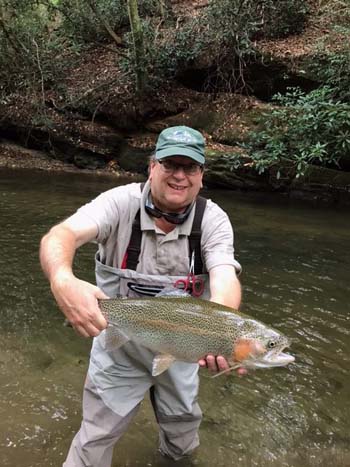
A wild rainbow trout from the upper Chattahoochee near Helen, Georgia.
Don’t let “gearing up” intimidate you

Steve Hudson is the author of over 30 books. He also teaches fly casting and fly tying and has been known to build fly rods. Hudson probably knows more about southern Appalachia’s fishing and hiking than anyone.
By Steve Hudson
If there’s one thing that’s universally true about fly fishing, it’s that gearing up can be complicated.
But what if gearing up could be made simpler?
It can be, and one way to do just that is to sing the song of tenkara.
That’s what I’m doing on a fine afternoon a week or so ago. I’m getting ready to enjoy a day of tenkara fishing up in the mountains. We’re in the midst of one of those brief warm spells that often characterize the approach of spring, and that’s all it takes to get me into a trouty frame of mine. Fishing is in my future!
But where – and how?
The “where” is easy. For the last few weeks I’ve had a hankering to fish the upper reaches of the Chattahoochee River. To get there, I’ll drive from Helen, turning off Alt. 75 at the little white church and then following Poplar Stump Road until it morphs into gravel and follows the river up into the Chattahoochee WMA. I’ll keep driving until things just look right, and then I’ll stop and grab the rod and see what happens next.
And the “how?”
Lately, in the interest of that “simplicity” thing, it seems as if I’ve been picking up a tenkara rod as much as anything.
Tenkara is a centuries-old Japanese approach to fishing with flies. It uses a fixed line about the same length of the rod, plus about 4 feet of 5X (or so) tippet. And that is all. The line attaches directly to the tip of the rod. There is no reel, and as a result life is suddenly simpler for sure.
I’ve talked about tenkara before here. Does it sound interesting to you?
On this day, I pick up a Tiny Ten 2 rod from Tiny Tenkara, a rod company based in Colorado. This is a delightful little rod for use on small mountain waters like the one I have in mind. It has a fully extended length of about 8 feet, making it an ideal rod for small, tight mountain streams. I’ll be playing with a couple of different lines – an extremely supple furled line as well as a classic level fluorocarbon monofilament line. To each, I’ll add the obligatory 4 ft. of tippet. On the end of the tippet I’ll tie a small reverse-hackle fly (a traditional sabaka kebari) or maybe a basic brown soft-hackle emerger of some sort. Which one? I’ll let the fish decide. They’ll let me know.
And with that, I’m ready to go
After a while, I come to a section of creek that’s to my liking. I pull off the road and park. Then I put on the waders (it’s kind of chilly outside) and pick up the rod and turn toward the water.
Five minutes later I stand beside the stream. The flow here is small – just a few yards across – and there’s not a lot of room for casting. But the little 8-foot Tiny Ten 2, which weighs only 2 ounces and collapses to a length of 13 inches, is right at home in the tight quarters of this beautiful mountain stream. In some areas, there’s room to make an actual cast, and the Tiny Ten 2 proves precise and accurate in its ability to put the fly where I want it to go.
In other places, streamside vegetation closes in and regular casting is impossible. That’s when I turn to the “bow-and-arrow” cast, a technique which allows me to almost slingshot the fly toward chosen targets. It’s a great technique for fishing small mountain streams, and the little rod does a great job there too.

The author used the Tiny Ten 2, an 8-foot tenkara rod, on a recent trip to fish for trout on the upper Chattahoochee near Helen, Georgia.
How are the trout reacting to all of this?
Well, several wild rainbows vote in favor of the small soft-hackled sakasa kebari (which is, at the risk of oversimplifying things, Japanese for “a fly with a reversed hackle).
I fish the fly subsurface through several promising runs,watching the junction of the line and the tippet for subtle signs of a strike. Sure enough, there are several! I get lucky and bring a few of them to the net, where I admire them and quickly release them back into the water. Sometimes I’ll even see a fish move to the fly, but when that happens I often strike too soon and miss the fish completely.
After a while I switch to a surface fly. I am concerned that it might be too cold for such imitations of adult aquatic insects, but it’s warmed a bit and I’ve seen some bugs (maybe stoneflies) flying over the water. I rummage in my fly box and find something that looks about right for imitating them, then cut off the subsurface fly and tie on the surface imitation instead. Fishing is slower with the dry fly, but even so I manage to coax two trout (a brown and a rainbow) come to the surface and strike.
Though there’s always the possibility of a minor trophy in this enlightened stretch of water, I encounter no big fish on this day. Most of the ones I tangle with are in the 4- to 6-inch range, a size which fits the water (and the rod) perfectly. But I do manage to lose one that seems a bit larger. Was it eight inches long? Maybe ten?
 Of course, if a fish gets away, it can be as big as I want it to be
Of course, if a fish gets away, it can be as big as I want it to be
You understand that, don’t you?
Of course you do.
So I figure that the one I lost went about five pounds!
NOTE:
Steve Hudson’s new book, TENKARA 101, is a perfect introduction to the art of tenkara-style fishing. It’s available from local outfitters or direct from the author at FlyBooks.net.
About the author
Steve Hudson is the author of over 30 books. He also teaches fly casting [tenkara and conventional] and fly tying and has been known to build fly rods. Hudson probably knows more about southern Appalachia’s fishing and hiking than anyone.







